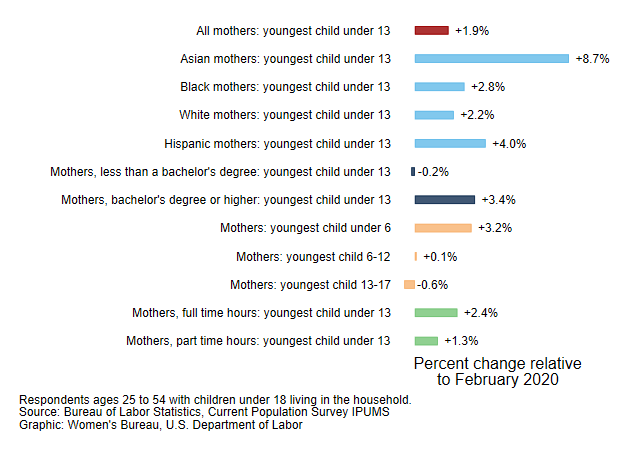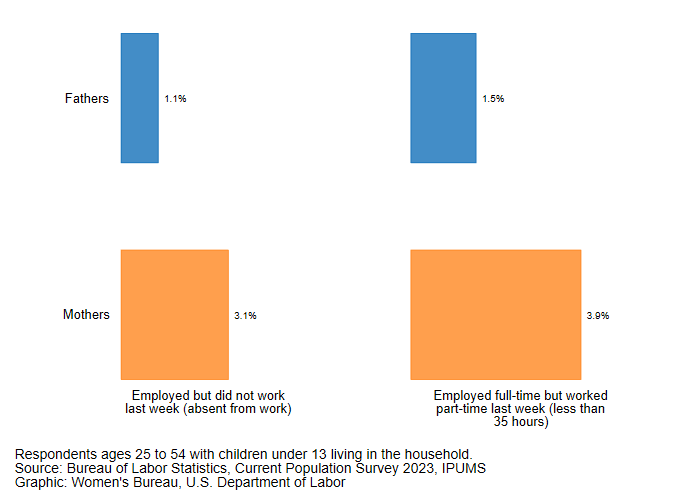The COVID-19 pandemic laid bare the precariousness of both employment and the caregiving infrastructure across the country. The huge shock to the economy, when coupled with the closure of schools and paid caregiving facilities, wreaked havoc on employment rates, and mothers’ employment in particular plummeted 15.7% from February to April 2020*. While many mothers stopped working during this time because their employers shut down, others left the labor force because they had no other option than to provide full-time care for their loved ones.
Now, four years later, overall maternal employment has largely recovered from the steep declines experienced at the onset of the COVID-19 pandemic. In fact, the share of employed mothers is 1.9% higher now than in February 2020, according to a Women’s Bureau analysis of the Current Population Survey. And while the speed of employment recovery varied for different groups of mothers, as of February 2024, maternal employment has more or less recovered for most groups of moms. For many groups of mothers – Asian moms, Hispanic moms, those with a bachelor’s degree and those whose youngest child is younger than six years – employment rates now exceed pre-pandemic levels. For other groups of mothers – those with less than a bachelor’s degree and those whose youngest child is 13 to 17 years old – employment rates now hover around pre-pandemic levels.
ACROSS MANY DEMOGRAPHIC GROUPS, MORE MOMS ARE EMPLOYED NOW THAN PRIOR TO THE COVID-19 PANDEMIC
Percent Change in Mothers’ Employment in February 2024 Relative to February 2020

One factor that may have contributed to the growth in employment for some U.S. mothers is the increasing prevalence of telework. In 2023, about 24.2% of mothers reported working from home at some point in the prior week, with rates rising to 26.8% among mothers with whose youngest child is under the age of six, according to a Women’s Bureau analysis of the Current Population Survey.
Although telework may be a valuable strategy for integrating work and family responsibilities for some, it is by no means a panacea. Many jobs – particularly service jobs, healthcare occupations and jobs in education – often do not offer telework options. Similarly, telework is often unavailable for those with less education: While 34% of mothers with only a bachelor’s degree and 36% of mothers with an advanced degree reported teleworking in the prior week, only 4% of mothers with less than a high school diploma reported teleworking. And even for those workers who can access it, telework is not a substitute for adequate, accessible and affordable child care. Indeed, childcare availability has become even more constrained as many childcare providers closed permanently or lost workers during the pandemic.
When a family has childcare issues, mothers miss work or reduce work hours more often than fathers. In 2023, among employed parents who did not work in the prior week, 3.1% of mothers and 1.1% of fathers reported childcare problems as the reason for not working, according to a Women’s Bureau analysis of the Current Population Survey. Similarly, among employed parents who normally worked full-time but worked part-time in the prior week, 3.9% of mothers and 1.5% of fathers reported childcare problems as the reason for working fewer hours.
MORE MOMS THAN DADS TAKE TIME OFF WORK FOR CHILD CARE
Percent of Employed Parents Who Did Not Work or Worked Part-Time in the Prior Week Due to Childcare Problems

Expanding and strengthening the U.S. care infrastructure could help alleviate these work disruptions and likely bolster mothers’ employment. Research from the Women’s Bureau finds that a 10% decrease in median childcare prices in a county is associated with a 1% increase in maternal employment. Improving the care infrastructure also means ensuring quality jobs and family-sustaining wages for childcare workers.
Expanded access to policies like paid family and medical leave could also improve stability in employment hours among those employed and reduce gender disparities in labor supply. While maternal employment has recovered and even exceeded pre-pandemic levels, the employment rate of mothers (71.7% in February 2024) remains far lower than that of fathers (92.0%). Estimates suggest that if the U.S. had a labor force participation rate similar to Canada or Germany – countries that both have national paid leave and more comprehensive family-supporting policies – the number of women employed would increase by about 5 million and generate over $775 billion in economic activity a year. Although their employment has finally returned to pre-pandemic levels, the lack of a robust care infrastructure may continue to prevent mothers from achieving their full potential in the labor force.
*Unless specified otherwise, data applies to mothers ages 25 to 54 with children under 13.
Erin George is an Economist at the Women’s Bureau.



